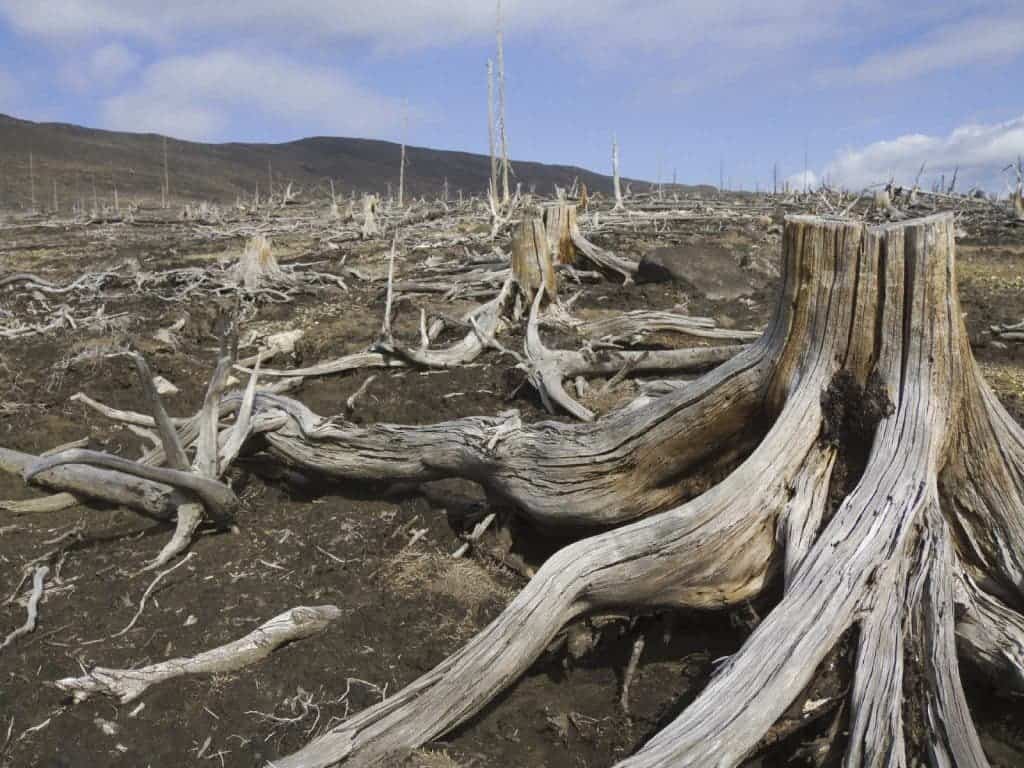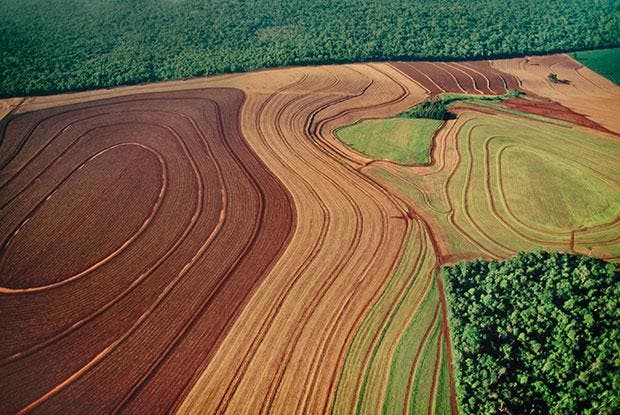
In the 1950s rainforests covered 14% of the earth’s land surface; now they cover a mere 6% and experts estimate that the last remaining rainforests could be consumed in less than 40 years. It’s believed that deforestation accounts for about 20% of global emissions of CO2, because of the a reduced carbon storage capacity. Yet there may be a hidden side to deforestation and how it influences climate, however, that few people see. Writing in Nature Climate Change, Professor Nadine Unger of the Yale School of Forestry & Environmental Studies (F&ES) reports that large-scale forest losses during the last 150 years have reduced global emissions of biogenic volatile organic compounds (BVOCs). These compounds, when combined with other found in the atmosphere, produce pollutants that contribute to global warming. Overall, Unger and her team found that the forests transformed into croplands worldwide triggered a net cooling effect on global temperatures, contrary to popular wisdom.
Turning forests into croplands cools the earth

Plants and animals emit VOCs and the release of these gaseous compounds affects the chemical and physical properties of the atmosphere. In the presence of NOx, produced by fossil fuel combustion and natural processes, biogenic VOCs react in the atmosphere to form tropospheric ozone, an important pollutant. These reactions may also cause a decrease in the concentrations of the hydroxyl radical (OH) and so lead to the accumulation of methane and other greenhouse gases. A further consequence of these reactions is the formation of secondary organic aerosol particles, a component of PM10 in the atmosphere, which has known adverse effects on human health.
The emissions of VOCs by plants are several orders of magnitude higher than by animals and account for a relevant amount of carbon fixed by photosynthesis, especially under stress conditions. So, these VOCs actually hinder how much carbon trees can soak, but why are these emitted in the first place and at such a large cost of resources? This is still debated, but scientists seem to agree that VOCs act as powerful deterrents against pathogens and herbivores, and also contribute to wound sealing. In the case of flowers, VOCs attract pollinators.
Using sophisticated climate modeling, Unger calculated that a 30-percent decline in BVOC emissions between 1850 and 2000, largely through the conversion of forests to cropland, produced a net global cooling of about 0.1 degrees Celsius. During the same time frame, average global temperatures have risen by 0.6 degrees Celsius, largely because of man-made CO2 emissions. While trees mitigate global warming, on one hand, by capturing and storing carbon, Unger’s model suggests that in the broader picture deforestation produces cooling.
So, carbon is sequestrated by the trees and kept from accumulating in the atmosphere where it traps heat and causes surface temperatures to rise. Meanwhile, the disappearance of dark-colored forests has also helped offset temperature increases through the so-called albedo effect – radiation that bounces off the planet back into space. Dark forests absorb heat, but light colored fields actually reflect heat back into space.
BVOCs when coming in contact with other naturally occurring or man-made substances can produce aerosols – fine, liquid or solid particles that contribute to global “cooling” since they generally reflect solar radiation back into space. Therefore, the model showed that a 50 percent reduction in forest aerosols has actually spurred greater warming since the pre-industrial era. Yet, the broader picture still resulted in a net cooling effect, since the percentage of the planet covered by cropland has more than doubled, from 14 percent to 37 percent since the mid-XIXth century.
“Land cover changes caused by humans since the industrial and agricultural revolutions have removed natural forests and grasslands and replaced them with croplands,” said Unger, an assistant professor of atmospheric chemistry at F&ES. “And croplands are not strong emitters of these BVOCs — often they don’t emit any BVOCs.”
More sophisticated climate models
It’s rather surprising, in light of these findings, that most climate models do not take into account BVOCs, since these emissions are generally perceived as a “natural” part of the earth system. Clearly, if you change the amount of surface covered by forests, then it doesn’t become a natural process anymore.
“Without doing an earth-system model simulation that includes these factors, we can’t really know the net effect on the global climate. Because changes in these emissions affect both warming and cooling pollutants,” she noted.
Unger is careful to note that her model doesn’t suggest that cutting down more trees will help the planet cool down. Instead, she argues that the findings should spark a greater interest in including BVOCs into climate models. Further research into the matter is also advised, since BVOCs and their interaction with the atmosphere are yet to be fully understood. A 2011 study by researchers at the same Yale School of Forestry & Environmental Studies found that “if you cut trees in the boreal region, north of 45° latitude, you have a net cooling effect. You release carbon into the atmosphere by cutting down trees, but you increase the albedo effect, the reflection of sunlight.” But in other parts, deforestation can cause warming. For instance, north of Minnesota the temperature has decreased on average 1.5°F because of deforestation, researchers found, while south of 35° latitude, the level of North Carolina, deforestation has led to increased warming. Also, let’s not forget that deforestation causes soil erosion, floods, desertification and, worst of all, loss of biodiversity – how do these elements fit into the greater picture?
Thus it becomes clear that the effects of deforestation are widely varied and complex – we need to know more before we can make any conclusive comments, but that’s what science is for. To study, to debate, to reach the truth.






